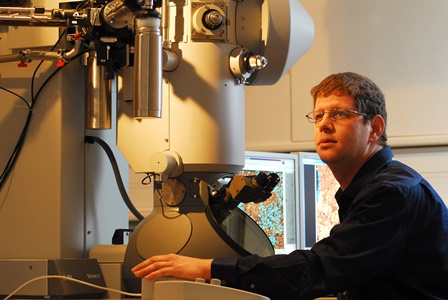
Cryo electron tomography (CET) reveals the macromolecular and structural organization within cells in a close-to-life state. It is, however, limited to thin specimens, such as peripheral areas of intact eukaryotic cells. Analysis of tissue ultrastructure requires physical thinning prior to the application of CET.
Now BGU researcher Prof. Ohad Medalia (pictured above) and his colleagues have further developed and demonstrated the use of ion beams to thin samples for CET imaging of vitrified multicellular tissues. By combining sample freezing directly on EM grids with the means for introducing gold nanocrystals markers on the surface of the CFIB-milled lamellae, they were able to produce high quality tomograms of vitrified C. elegans embryos and worms.
The paper was just published online in Nature Methods.
“The method described here offers a general solution for acquiring high-resolution tomograms on thick cells and tissues in diverse imaging settings. CET can now be implemented to resolve macromolecular structures from tissues, thus bridging the gap between developmental, cellular and structural biology,” says Medalia, a member of the Department of Life Sciences and the National Institute for Biotechnology in the Desert.
The article, “Structural Analysis of Multicellular Organisms with Cryo-Electron Tomography” was written byJan Harapin1, Mandy Börmel1,2, K Tanuj Sapra1, Damian Brunner2, Andres Kaech3 & Ohad Medalia1,4,5
1 Department of Biochemistry, University of Zurich, Zurich, Switzerland
2 Institute of Molecular Life Sciences, University of Zurich, Zurich, Switzerland
3 Center for Microscopy and Image Analysis, University of Zurich, Zurich, Switzerland
4 Department of Life Sciences in the Negev, Ben-Gurion University,Beer-Sheva, Israel
5 National Institute for Biotechnology in the Negev, Ben-Gurion University, Beer-Sheva, Israel
The following funding acknowledgements from the authors appear at the end of the paper:
This work was supported by a European Research Council (ERC) Starting Grant (243047 INCEL) and the Swiss National Science Foundation (SNSF 31003A_141083/1).
